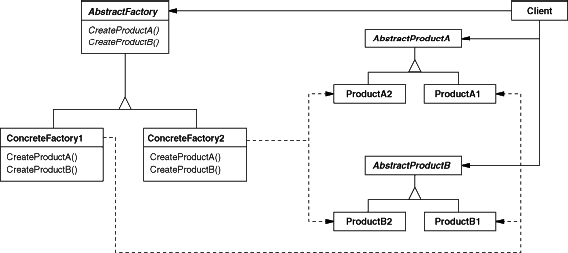Layering & Contract Philosophy With additional indirection
Abstract Factory

1 //The example code is as following: 2 class CAbstractProductA; 3 class CAbstractProductB; 4 // multiple families of products. 5 class CProductA1:public CAbstractProductA; 6 class CProductB1:public CAbstractProductB; 7 class CProductA2:public CAbstractProductA; 8 class CProductB2:public CAbstractProductB; 9 10 class CAbstractFactory 11 { 12 public: 13 virtual CAbstractProductA* CreateProductA() = 0; 14 virtual CAbstractProductA* CreateProductB() = 0; 15 }; 16 class CConreateFactory1:public CAbstractFactory; //indirection layer 17 { 18 public: 19 virtual CAbstractProductA* CreateProductA() { return new CProductA1; } 20 virtual CAbstractProductB* CreateProductB() { return new CProductB1; } 21 } 22 class CConreateFactory2:public CAbstractFactory;//indirection layer 23 { 24 public: 25 virtual CAbstractProductA* CreateProductA() { return new CProductA2; } 26 virtual CAbstractProductB* CreateProductB() { return new CProductB2; } 27 } 28 29 class CClient 30 { 31 public: 32 CAbstractFactory *pFactory = NULL; 33 void main() 34 { 35 if ( the system is windows )
{ 36 pFactory = new CConreateFactory1();
} 37 else
{ 38 pFactory = new CConreateFactory2(); 39 } 40 CAbstractProductA *pProductA = pFactory->CreateProductA(); 41 CAbstractProductB *pProductB = pFactory->CreateProductB(); 42 } 43 };
Applicability
Use the Abstract Factory pattern when:
- A system should be independent of how its products are created, compose /decompose, and represented.
- A system should be configured with one of multiple families of products.
- A family of related product objects is designed to be used together, and you need to enforce this constraint.
- You want to provide a class library of products, and you want to reveal just their interfaces, not their implementations. Interface-Oriented programming, Open For Extension, Close For Change,These All is said to Users or Client. Users don’t care or never know what is changed, so called “Close For Change”.
- You want to create a set of product without changing client code. Just create a new pointer to the object instantiated with class derived from base class AbstractClass.
Participants
- AbstractFactory (WidgetFactory): declares an interface for operations that create abstract product objects.
- ConcreteFactory (MotifWidgetFactory, PMWidgetFactory):implements the operations to create concrete product objects.
- AbstractProduct (Window, ScrollBar):declares an interface for a type of product object.
- ConcreteProduct (MotifWindow, MotifScrollBar): concrete / specific defines a product object to be created by the corresponding concrete factory,implements the AbstractProduct interface.
- Client: uses only interfaces declared by AbstractFactory and AbstractProduct classes.
Collaborations
- Normally a single instance of a ConcreteFactory class is created at run-time.This concrete factory creates product objects having a particular implementation. To create different product objects, clients should use a different concrete factory.The Client get the a pointer or reference from the Singleton object created with ConcreteFactory at run-time.
- AbstractFactory defers creation of product objects to its ConcreteFactory subclass.
From:Design Patterns:Elements of Reusable Object-Oriented Software, by GoF